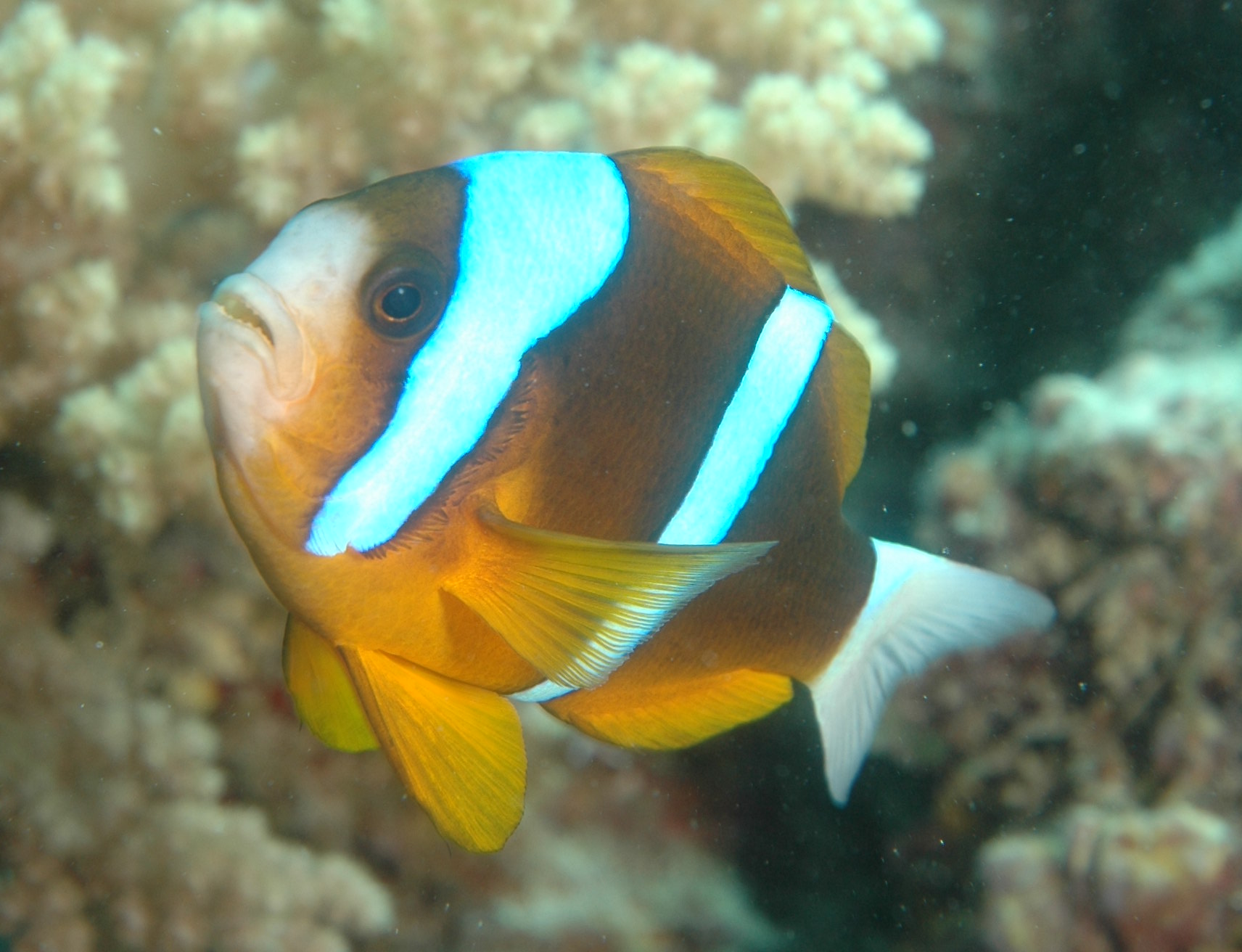- Barrier Reef Anemonefish
Taxobox
name = Barrier Reef Anemonefish

status =
regnum =Animal ia
phylum = Chordata
classis =Actinopterygii
ordo =Perciform es
familia =Pomacentridae
subfamilia =Amphiprioninae
genus = "Amphiprion "
species = "A. akindynos"
binomial = "Amphiprion akindynos"
binomial_authority = (Allen, 1972)The Barrier Reef Anemonefish, "Amphiprion akindynos", is an
anemonefish of the familyPomacentridae . It is native to reefs and marine lagoons of the Western Pacific.Description
Adults are an orange-brown color with two white bars with black edging encircling the body. The first bar is located on the head behind the eyes and may be thin and broken. The second bar is on the body below the
dorsal fin . Thecaudal peduncle andcaudal fin are white. Juveniles are normally brown with three white stripes. In sub-adults the colouring changes to a dull yellow with two white stripes. They have 10 to 11 dorsal spines and 2 anal spines. They reach a maximum length of 9 cm (3½ in) and weigh on average 27.50 g (0.97 oz).Distribution and habitat
The Barrier Reef Anemonefish is found in
lagoon s and outer reefs to depths of 25 m in theGreat Barrier Reef ,Coral Sea , northernNew South Wales ,New Caledonia , theLoyalty Islands andTonga . They prefer water temperatures between 10 and 32°C. They are usually found near to or within the tentacles of their host anemones: theBubble-tip anemone , "Entacmaea quadricolor"; theSebae anemone , "Heteractis crispa"; the Magnificent Anemone, "Heteractis magnifica"; theWhite Beaded Anemone , "Heteractis aurora"; theGreen Carpet Anemone , "Stichodactyla haddoni"; and Merten's Sea Anemone, "Stichodactyla mertensii". They are unaffected by the stinging tentacles due to a substance in the mucous covering their bodies which prevents thenematocyst s (stinging cells) from firing.ocial structure
The Barrier Reef Anemonefish live together in a social structure within a single anemone. A dominant female is the largest member of the group, and her mate, the dominant male, the second largest. There are also up to four lower-ranking males. There is little aggression from the large female toward the males, but fierce in-fighting between the males maintains the pecking order. The lowest ranking male may be driven out and forced to seek a place in a group within another anemone host or die. If the female dies, the dominant male assumes her position within the hierarchy and over the course of a few days changes sex. In the wild they may live 6-10 years, but captive species have survived for 18 years.
Reproduction
The Barrier Reef Anemonefish is a nesting fish. A few days before mating aggression from the dominant male towards the female increases, and at the same time he begins clearing a nest site, usually on a rock close to the host anemone. The rock is cleaned of
algae , sometimes with the assistance of the female. When spawning takes place the female zig-zags over the nest site and the male follows fertilizing the eggs which have been deposited. Between 100 and 1000 elliptical eggs of between 3 and 4 mm in length may be laid. They are attached to the nest site by a mass of short filaments. The male guards the nest for 6 to 7 days until the eggs hatch. All the fry are born sexless - they develop into males first, and into females only if they rise to the top of the hierarchy within a particular hosted group.Diet
The diet of the Barrier Reef Anemonefish consists primarily of algae and
zooplankton . The dominant pair in the social hierarchy tend to travel farther from the host anemone in order to find food. The host anemone may benefit from small pieces of food which the anemonefish drop when feeding.References
*
* cite web|url=http://animaldiversity.ummz.umich.edu/site/accounts/information/Amphiprion_akindynos.html
title="Amphiprion akindynos" (barrier reef anemonefish)|publisher=University of Michigan Museum of Zoology|date=1995|accessmonthday=11 January|accessyear=2007
Wikimedia Foundation. 2010.
